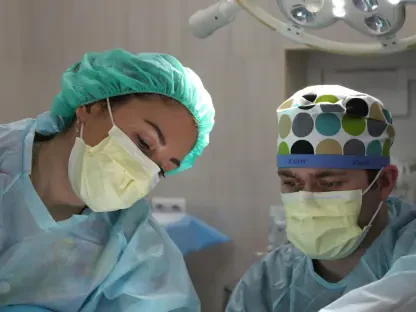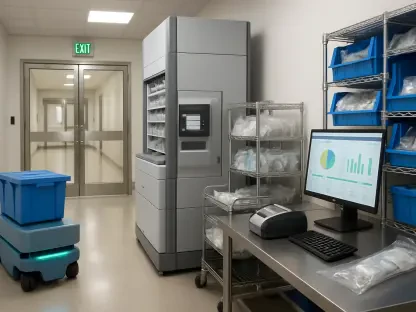Congenital heart disease (CHD) remains a critical health concern globally, affecting approximately 8 out of every 1,000 newborns and representing over a quarter of all major birth defects, making it a leading cause of infant morbidity and mortality. While traditional diagnostic methods like echocardiography have long been the cornerstone of CHD evaluation, they often fall short when it comes to assessing complex extracardiac structures. Enter multi-detector computed tomography (MDCT), a cutting-edge imaging technology that has transformed the landscape of CHD diagnosis. By offering high-resolution, three-dimensional views of both cardiac and surrounding vascular anatomy, MDCT provides unparalleled detail that is vital for preoperative planning and postoperative follow-up. This article delves into the significant contributions of MDCT in diagnosing CHD, drawing from a comprehensive study of Egyptian children to highlight its diagnostic precision, epidemiological insights, and technological advantages. The focus is on how this advanced tool addresses the limitations of other modalities and paves the way for improved patient outcomes through detailed anatomical visualization.
1. Understanding the Scope of Congenital Heart Disease
Congenital heart disease represents a spectrum of structural anomalies in the heart that are present from birth, varying widely in severity and impact. These conditions are traditionally classified into cyanotic types, where reduced oxygen levels lead to visible bluish skin, and acyanotic types, where oxygenation remains unaffected. Common cyanotic CHDs include tetralogy of Fallot (TOF), transposition of the great arteries (TGA), and total anomalous pulmonary venous drainage (TAPVD), while acyanotic defects often involve ventricular septal defect (VSD) and atrial septal defect (ASD). The global burden of CHD underscores the urgent need for accurate diagnostic tools to guide timely interventions. With survival rates improving due to advances in cardiovascular diagnostics and surgical techniques, the ability to precisely map these defects becomes even more critical for long-term management. MDCT stands out by offering a detailed perspective that complements other methods, ensuring that even the most intricate anomalies are not overlooked during clinical assessments.
The significance of CHD as a public health issue cannot be overstated, particularly in regions with high birth rates and varying access to advanced medical care. The prevalence of these conditions necessitates robust imaging solutions that can cater to diverse patient populations, including infants and young children who require non-invasive yet precise evaluations. MDCT has emerged as a pivotal tool in this context, capable of capturing detailed images of the heart and surrounding structures in a matter of seconds. This capability is especially beneficial for pediatric patients, reducing the need for sedation compared to other imaging modalities and minimizing discomfort. By providing a clearer picture of both intra-cardiac and extracardiac abnormalities, MDCT helps clinicians tailor interventions to the specific needs of each patient, thereby enhancing the likelihood of successful outcomes in challenging cases.
2. Methodology Behind MDCT Assessment in CHD Diagnosis
A detailed retrospective analysis involving 619 CHD patients, ranging from newborns to 14-year-olds, was conducted at a prominent pediatric hospital in Egypt over a two-year period. Strict exclusion criteria were applied, omitting postoperative patients, those with acquired heart conditions like rheumatic heart disease, and individuals with impaired kidney function or severe contrast allergies. Informed consent was secured from guardians, and comprehensive patient histories—including age, weight, symptoms like cyanosis, and past medical interventions—were meticulously gathered from hospital records or direct interviews. Pre-procedure preparations involved kidney function tests to prevent contrast-induced complications, fasting for 3–4 hours to avoid vomiting risks, and sedation for children under 8 years using oral chloral hydrate, while older cooperative patients were exempted if they could follow instructions. Intravenous access was established, prioritizing the right antecubital vein for optimal contrast delivery during imaging.
The imaging process utilized advanced equipment, including a 64-MDCT Toshiba scanner and a GE BrightSpeed Elite 16 CT scanner, to ensure high-quality results. Patients were positioned supine, and a low-osmolar, water-soluble iodine-based contrast agent was administered at a dosage of 1.5–2 mL/kg through an automated injector, with flow rates adjusted based on age. Real-time contrast bolus tracking optimized scan timing, targeting a threshold of approximately 100 Hounsfield units in key vascular regions. ECG-gated imaging minimized motion artifacts, enhancing visualization of cardiac and vascular structures, with scans covering from the neck base to the upper abdomen at a slice thickness below 1 mm. Post-processing on specialized workstations enabled 2D multi-planar reformatted images and 3D reconstructions, focusing on cardiac position, chamber analysis, vascular assessments, and specific defect characteristics like aortic overriding in TOF. This structured approach ensured that MDCT provided a comprehensive diagnostic framework for complex CHD cases.
3. Epidemiological Insights from MDCT Findings
The demographic breakdown of the studied cohort revealed a predominance of male patients, accounting for 61% of the 619 cases, compared to 39% female, with a median age of 12 months. This distribution highlights potential gender disparities in CHD presentation or referral patterns that warrant further exploration. Cyanotic CHD comprised 55% of cases, with tetralogy of Fallot leading as the most common subtype at 64.3%, often accompanied by identifiable features such as overriding aorta and pulmonary stenosis through MDCT imaging. Other cyanotic conditions included double outlet right ventricle, pulmonary atresia, and transposition of the great arteries, each presenting unique diagnostic challenges that MDCT effectively addressed by mapping intricate vascular anomalies. These findings underscore the technology’s role in identifying critical structural issues that impact surgical planning and long-term care strategies for affected children.
In contrast, acyanotic CHD accounted for 45% of the cases, with coarctation of the aorta and left-to-right shunts emerging as the most frequent subtypes at 16% and 13.6%, respectively. MDCT proved instrumental in providing precise measurements of narrowed segments in coarctation cases and evaluating associated complications like pulmonary hypertension in septal defects. Conditions such as aortic and pulmonary stenosis, truncus arteriosus, and coronary anomalies were also detailed with exceptional clarity, facilitating targeted therapeutic approaches. The ability of MDCT to detect extracardiac vascular anomalies alongside complex intra-cardiac defects positions it as an indispensable tool in modern pediatric cardiology, offering insights that are often beyond the reach of traditional imaging methods like echocardiography. This comprehensive diagnostic capability ensures that even subtle abnormalities are accounted for in treatment planning.
4. Advantages of MDCT Over Traditional Imaging Modalities
MDCT offers distinct advantages over echocardiography, the conventional first-line imaging tool for CHD, particularly in its ability to assess extracardiac structures with high spatial resolution. While echocardiography excels in safety and bedside accessibility, its operator-dependent nature and limited capacity to visualize beyond the heart often necessitate a secondary modality for complex cases. MDCT fills this gap by providing detailed imaging of the coronary arteries, pulmonary vessels, and systemic veins, which are critical for a complete understanding of CHD anatomy. This technology is especially valuable in preoperative settings, where precise mapping of anomalies like major aortopulmonary collaterals in TOF or the exact location of stenosis in coarctation of the aorta can significantly influence surgical outcomes. Additionally, the rapid acquisition times of MDCT reduce the need for prolonged sedation, a notable benefit for pediatric patients.
Beyond anatomical precision, MDCT’s integration of advanced features such as ECG gating and 3D reconstruction enhances its diagnostic utility. These capabilities allow for dynamic assessment of cardiac structures with minimized motion artifacts, offering a clearer picture of complex defects like anomalous pulmonary venous drainage in TAPVD. Even in resource-limited settings, the effectiveness of 16 and 64-slice MDCT scanners demonstrates that impactful results are achievable without the latest equipment, broadening the applicability of this technology. However, challenges such as radiation exposure remain a concern, though adherence to pediatric dose-reduction protocols mitigates some risks. By overcoming the limitations of invasive methods like conventional angiography, MDCT establishes itself as a non-invasive yet powerful adjunct that redefines diagnostic accuracy in CHD management, paving the way for tailored medical interventions.
5. Challenges and Limitations in MDCT Application
Despite its numerous benefits, the application of MDCT in CHD diagnosis is not without hurdles, particularly regarding its implementation in varied clinical environments. One significant limitation is the single-center nature of many studies evaluating MDCT, which may not reflect broader national or regional patterns of CHD distribution or imaging practices. Such localized data can skew epidemiological insights and limit the generalizability of findings to diverse populations with differing access to healthcare resources. Furthermore, while MDCT excels in anatomical imaging, it falls short in assessing functional parameters like pressure gradients or shunt volumes, which are often crucial for comprehensive clinical decision-making. This gap highlights the need for complementary diagnostic tools to provide a holistic view of a patient’s condition.
Another pressing concern is the issue of radiation exposure associated with MDCT, especially in pediatric patients who may require repeated imaging over time. Although modern protocols prioritize dose reduction to minimize risks, the long-term effects of cumulative exposure remain understudied and pose a potential health concern. Balancing the diagnostic benefits of MDCT with safety considerations requires ongoing advancements in low-dose imaging techniques and careful patient selection for scans. Additionally, the technology’s reliance on contrast agents introduces risks for those with kidney impairments or allergies, necessitating thorough pre-procedure evaluations. Addressing these challenges through technological innovation and standardized guidelines will be essential to maximize MDCT’s benefits while safeguarding patient well-being in the context of CHD diagnosis.
6. Looking Ahead: Future Prospects for MDCT in Pediatric Cardiology
Reflecting on the strides made in CHD diagnosis, MDCT has proven to be a transformative force in pediatric cardiology by delivering high-resolution, non-invasive imaging that complements traditional methods. Its capacity to detail both cardiac and extracardiac structures with precision plays a crucial role in enhancing preoperative planning and postoperative evaluations for countless young patients. The epidemiological insights gained from studies using MDCT clarify the distribution of cyanotic and acyanotic CHD, offering valuable data that inform clinical practices and highlight the technology’s unique diagnostic strengths. By addressing the shortcomings of echocardiography and invasive angiography, MDCT establishes a new standard for accuracy in identifying complex anomalies, ensuring that surgical interventions are based on the most comprehensive anatomical information available.
Moving forward, the evolution of MDCT technology promises even greater impact through innovations aimed at reducing radiation risks and enhancing image quality. The development of low-dose imaging protocols will be critical in minimizing exposure, particularly for pediatric patients requiring multiple scans. Additionally, the integration of artificial intelligence-driven image processing is expected to streamline diagnostic workflows, improving the detection of subtle abnormalities and reducing interpretation times. These advancements will likely expand MDCT’s accessibility, even in resource-constrained settings, ensuring that more children benefit from cutting-edge diagnostics. As research continues to refine these tools, the focus should remain on balancing technological progress with patient safety, ultimately fostering better outcomes for those affected by congenital heart disease.









